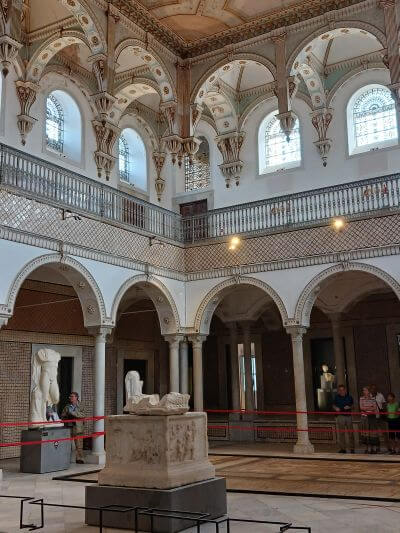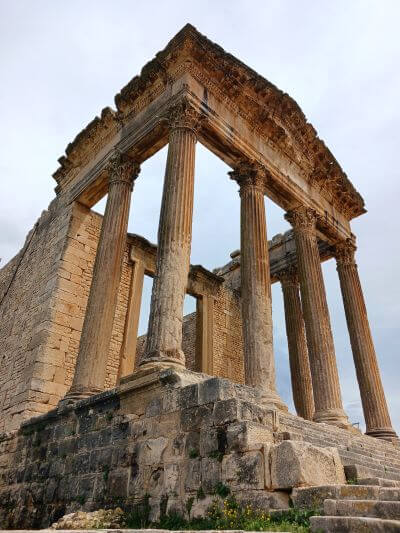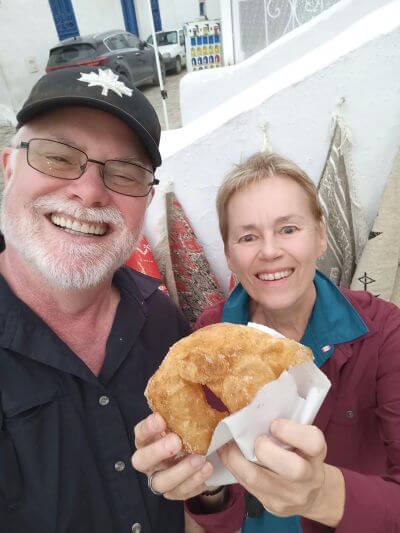
When we left Constantine, Algeria for Tunisia, annoyingly we had to fly west to Algiers then backtrack east flying directly over the city we’d just left! All because of uncertainty about being able to cross the land border. Consequently, most of a day was spent getting into Tunis, Tunisia. Some hard bargaining with the taxi drivers at the airport got us a ride to our hotel in Sidi Bou Said at only triple the actual metered price. We were definitely back in a heavily touristed country!
After an extremely hectic 10 days in Algeria, our time in Tunisia was planned to be slow paced and relaxed, and so it was, comparatively speaking. While we did stay outside the downtown core in the blue and white village of Sidi Bou Said and then in the seaside suburb of La Marsa, we made time to visit the UNESCO sites of Carthage and Dougga, as well as the medina and the Bardo Museum in the centre of Tunis. We have divided up our photos from our week in Tunisia accordingly.

Carthage and the Bardo Museum
CLICK HERE or on the image for our Carthage and the Bardo Museum album.
Our hotel was in the pedestrian area of Sidi Bou Said, but just a short walk down the hill through the gauntlet of souvenir sellers brought us to the taxi stand for the 10-minute drive to the Baths of Antoninus. Carthage, founded as a Phoenician trading post over 3,000 years ago, is a huge site spread out in pockets in a northern suburb of Tunis. The baths, despite being only a few meters from the ocean, were fed by a 132 km aqueduct of fresh mountain water, accumulated in huge cisterns. Our walking tour of the baths was not all that informative, but we did get to see the tepidarium, caldarium, and frigidarium as well as the immense furnace and the firewood storage nearby that were needed to heat the whole affair. We walked part way up Byrsa Hill to the next two sites, the Roman theatre (heavily reconstructed and so not that interesting) and Roman villas, some with mosaics and statues in place. Continuing to the top of Byrsa Hill brought us to the 19th century Saint Louis Cathedral and a closed museum, but provided spectacular views over Tunis, and many of the sites of Roman Carthage. The only trace of Phoenician Carthage visible was the Punic harbour; the rest of pre-Roman Carthage was razed to the ground when Rome finally won the Third Punic War. Our final stop was at the Cisterns of La Malga. These cisterns at the end of the aqueduct were simply huge (as they had to be to hold the water supply for a city of 500,000 people!) and were at the terminus of the impressive aqueduct.
We have included our images from the Bardo Museum with our Carthage pictures since all of the good mosaics and sculptures from around Tunisia are in this museum within a palace in downtown Tunis.

Dougga and Bulla Regia
CLICK HERE or on the image for our Dougga and Bulla Regia album.
We booked a day trip to the UNESCO World Heritage site of Dougga, and continued on to Bulla Regia to see underground Roman villas.
The drive of a couple of hours was through rolling hills of farms and pastures. A quick stop to see a mosque in Testour, then a morning snack at a wood-fired bakery at the side of the road before arriving at Dougga. This Roman site was better than Carthage in some ways; much better preserved and not spread out over multiple areas. UNESCO calls it “the best-preserved Roman small town in North Africa“. The theatre and the Capitol were particularly impressive.
After Dougga, we drove to Bulla Regia which is notable for having many Roman villas withe main living and entertaining areas underground. Sadly, only a couple of the villas have an intact roof and have their mosaic floors in place. Some are closed due to the imminent danger of a roof collapse, others have had their mosaics relocated to the Bardo Museum. Unfortunately, money for preserving archaeology sites in Tunisia is scarce!

Sidi Bou Said, La Marsa, and Tunis
CLICK HERE or on the image for our Sidi Bou Said, La Marsa, and Tunis album.
Sidi Bou Said, La Marsa, and Tunis
Tunisia is known as a beach destination, for easy access to the Sahara, and as the shooting location for many of the Star Wars films. We went against the grain and didn’t go to any of those places. Instead, we stayed in the northern part of the country to explore historical sites and enjoy towns on the Mediterranean shore.
The first place that we stayed was the pretty blue and white town of Sidi Bou Said. Most tourists visit for a couple of hours to take photos of the famous blue doors and enjoy a giant, sugary doughnut called a bambalouni. We stayed for three days to enjoy some fusion cooking (north African, French, and Italian), a nice hotel, and proximity to the UNESCO site of Carthage. (See our photos and write-up above.) Some great restaurants, even some with wine thanks to the French influence in a Moslem country.
We then moved to another northern suburb of Tunis, La Marsa. The twin attractions of La Marsa are that it’s right on the sea, and that road and rail connections are easy. Our hotel was right on the shore and just a short walk from the main square, coffee shops, and restaurants. The train station was also near the square, but unfortunately the rail link to downtown Tunis was under repair so we ended up taking taxis to downtown Tunis a couple of times, just a 20-30 minute ride away.
We went into Tunis twice, once to visit the medina (the formerly walled old city), and again to visit the Bardo Museum (which we have included with Carthage above). Tunis has a few attractive buildings from the French colonial era but wasn’t particularly walkable. The medina on the other hand was pretty good, with mosques, rooftop views, and some interesting people watching in the shops and alleyways. Also some tasty street food for lunch!
See the short photo album for the week directly on Flickr: www.flickr.com/photos/100countries/albums/72177720326258454












